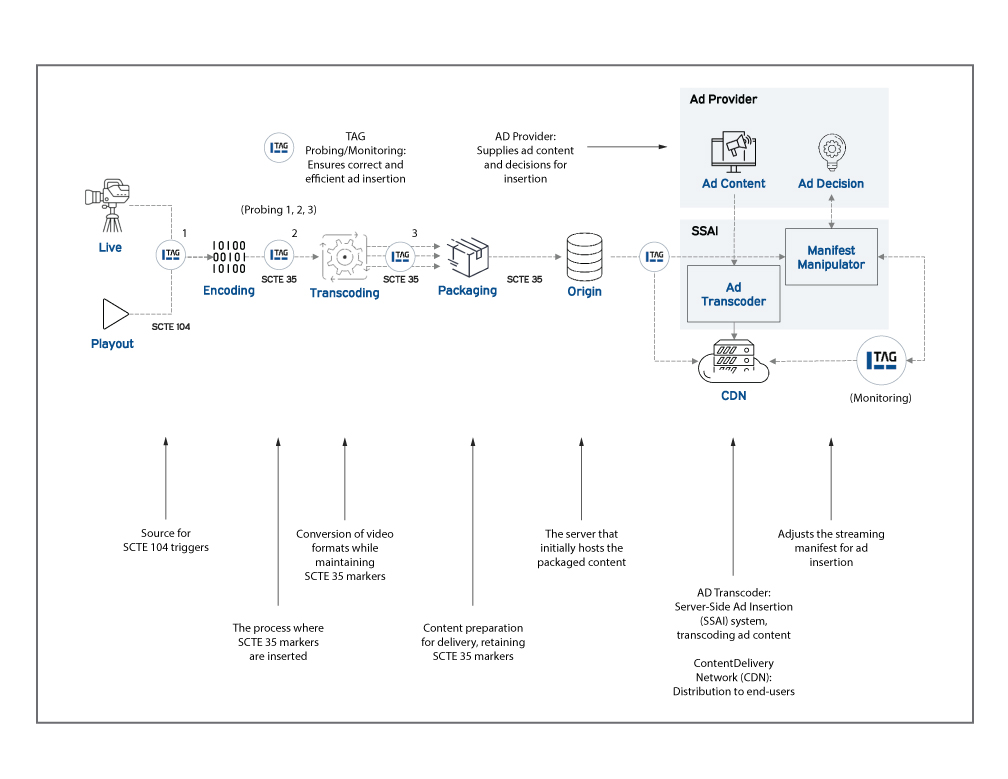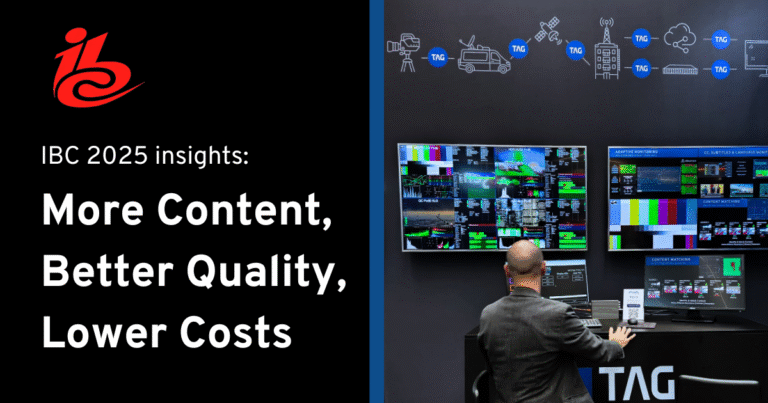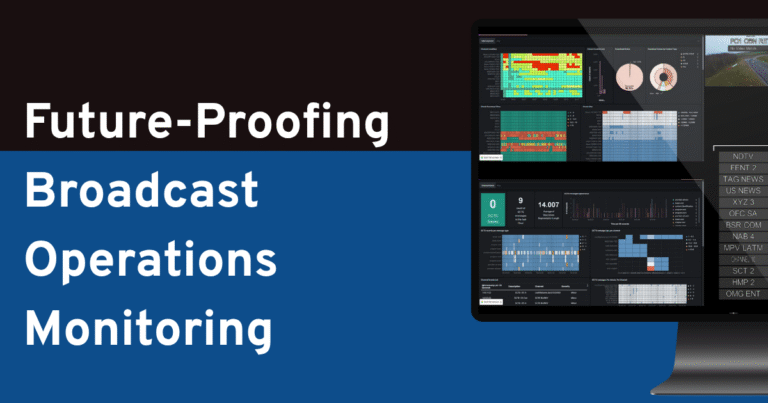Introduction
As the media industry evolves, the significance of digital ad insertion in video streaming grows. Over-the-top (OTT) and free ad-supported streaming television (FAST) are expanding rapidly, driven by the demand for personalized content delivery and the potential for substantial ad revenue. However, this growth comes with challenges, particularly in ensuring seamless ad insertion without disrupting the viewer experience. Effective monitoring of ad insertion is crucial to address these challenges, minimize revenue loss, and maximize viewer engagement. This white paper explores the necessity of monitoring ad insertion, the technologies involved, and how TAG Video Systems can assist customers in achieving optimal ad insertion performance.
Technology Overview
SCTE-104 and SCTE-35 are important standards in digital ad insertion. Developed by the Society of Cable Telecommunications Engineers (SCTE), SCTE-104 defines how cue messages are inserted into baseband video streams via TCP/IP before encoding. These markers are then translated into SCTE-35 markers, residing within the MPEG-TS signal. SCTE-35 provides guidelines for inserting or splicing content into the stream, ensuring seamless ad integration without disrupting the viewing experience. These markers signal to broadcasters and OTT platforms where ad content can be inserted, enabling targeted and personalized advertising.
This diagram illustrates the complete ad insertion workflow, showcasing how different technologies and processes interconnect to deliver a seamless viewing experience. The use of SCTE 104 triggers at the playout level initiates the process, while SCTE 35 markers ensure continuity through encoding, transcoding, and packaging stages. TAG’s monitoring ensures that the entire process remains flawless by identifying and addressing any issues in real-time.
Ad Insertion Monitoring
TAG Video Systems provides comprehensive monitoring solutions for ad insertion in video streaming. The system encompasses real-time deep probing and analysis across the entire workflow, from live sources to encrypted OTT distribution points. TAG’s monitoring capabilities extend to various formats and distribution points, including OTT, FAST, and traditional broadcasting environments.
Here’s what TAG’s monitoring system does:
- Real-Time Monitoring: Keeps an eye on all distribution points, including encrypted signals inside Content Delivery Networks (CDNs), and provides complete probing and analysis of SCTE-104 and SCTE-35 messages. Each message is decoded to give operators a detailed, human-readable representation.
- Long-Term Storage: Stores both binary messages and decoded versions for reporting and analysis.
- Adaptive Monitoring: Reduces monitoring costs while ensuring thorough analysis through TAG’s Adaptive Monitoring technology.
- Multiviewer Visualization: Offers real-time multiviewer visualization of signals.
- Advanced Error Detection: Features monitoring by exception tools and automatic capture of OTT signals for forensic analysis in case of errors.
SCTE Parameters
The TAG platform monitors several important parameters within SCTE standards, which are necessary for ensuring proper ad insertion. These parameters include signals that mark the start and end of programs, ad segments, and network transitions. Monitoring these parameters ensures that ad insertion opportunities are accurately identified and utilized, preventing revenue loss and maintaining a seamless viewing experience.
Key Features of TAG's Monitoring Solution
TAG’s monitoring solution offers several key features that set it apart:
- Real-Time Deep Probing: Ensures all potential faults in the ad insertion workflow are promptly identified and addressed, reducing the likelihood of missed ad opportunities and revenue loss.
- Flexible and Robust System: Designed to handle the complexities of modern OTT and FAST environments, offering unparalleled flexibility and robustness.
- Scalability: TAG’s Adaptive Monitoring technology optimizes monitoring costs while maintaining comprehensive coverage, making it suitable for both large-scale operations and smaller enterprises.
- Actionable Insights: Advanced monitoring by exception tools and detailed forensic analysis enable customers to swiftly address and resolve issues, maintaining uninterrupted service and high viewer satisfaction.

This dashboard simulation and HEX code example focus on the monitoring and reporting capabilities of TAG Video Systems for SCTE 35 markers. It includes: 1. Centralized Source View: Aggregation of SCTE message data for a comprehensive overview. 2. HEX Format Storage: TAG stores markers in HEX format for efficient reporting. 3. Kibana Dashboard: Visualization tool used to display detailed metrics and insights. 4. SCTE Issues and Statistics: Real-time tracking of SCTE messages, descriptors, and segmentation length. 5. Detailed Reporting: Includes aggregated ad statistics and individual splice events. 6. Ad Revenue Assurance: Ensures optimal ad revenue through precise tracking and analysis of SCTE markers.
Summary
In the rapidly growing landscape of digital ad insertion in video streaming, effective monitoring is essential to ensure seamless ad integration and maximize revenue opportunities. SCTE-104 and SCTE-35 technologies provide the foundational standards for ad insertion, enabling targeted and personalized advertising. TAG Video Systems stands out as a leader in this field, offering a comprehensive and scalable monitoring solution that addresses the complexities of modern OTT and FAST environments.
TAG’s system excels in real-time deep probing, adaptive monitoring, and advanced error detection, ensuring that ad insertion workflows operate smoothly and efficiently. For customers, this translates into protected ad revenue, enhanced viewer experience, and improved operational efficiency. As the media industry continues to evolve, TAG Video Systems remains a trusted partner in optimizing ad insertion performance and driving success in digital advertising.
APPENDIX
Research of TAG Knowledge Base
- SCTE A – https://tag.atlassian.net/wiki/spaces/UPGRADES/pages/423690554/SCTE-35+A
- SCTE B – https://tag.atlassian.net/wiki/spaces/UPGRADES/pages/423690558/SCTE-35+B
- SCTE 104 – https://tag.atlassian.net/wiki/spaces/UPGRADES/pages/522256385/SCTE+-104
The TAG Solution has many SCTE triggers, grouped and categorized as SCTE A, SCTE B, and SCTE 104. In all, there are over 100 probes that monitor SCTE errors
SCTE 35A (IDs 251,52; 259-299; 330-353; 500-513); SCTE 35B (IDs 253; 401-430; 514-727), and
SCTE 104 (IDs 451-485)
For day-to-day operations, several SCTE-35 and SCTE-104 triggers are particularly relevant due to their direct impact on ad revenue. Here are the most important ones:
SCTE-35 Triggers
1. SCTE-35 OutOfNetwork Signal – In/Out:
- ID 251 and 252: These flags indicate the points where content can be inserted or exited. Mismanagement of these signals can lead to missed ad insertion opportunities or inappropriate content insertion, directly affecting ad revenue.
2. Program Start/End:
- ID 261 and 262: Accurate signaling of program start and end times is crucial for ensuring that ads are placed correctly. Errors here can lead to ads being missed or improperly timed, which negatively impacts ad revenue.
3. Advertisement Start/End:
- ID 272, 273, 274, and 275: These signals mark the start and end of ad segments. Errors or missed triggers in these signals can result in ads not being shown, directly causing revenue loss.
4. Splice Insert/Time PTS Out of Range:
- ID 259: Ensures that the splice points for ads are within the correct time window. If these are out of range, ads may not be inserted correctly, leading to revenue loss.
5. Placement Opportunity Start/End:
- ID 276 and 277: These signals mark opportunities for inserting content, such as ads. Missing these opportunities can directly result in lost ad revenue.
SCTE-104 Triggers
1. Inject Response and Inject Complete Response:
- ID 456 and 457: These signals indicate that an ad insertion command has been received and executed. Any errors in these triggers can result in the failure of ad insertion commands, impacting revenue.
2. Inject Section Request and Slice Request:
- ID 466 and 467: These are requests to generate and send SCTE-35 messages. Errors here can prevent ads from being inserted as scheduled.
3. Alive Request/Response:
- ID 454 and 455: These signals ensure the system is operational and able to insert ads. Failures here can indicate broader system issues that could prevent ad insertions.
Impact on Ad Revenue
- Missed Opportunities: If triggers for ad start/end or placement opportunities are missed, ads may not be inserted, directly reducing ad revenue.
- Incorrect Timing: Splice inserts or PTS out of range errors can lead to ads being placed at incorrect times, disrupting the viewer experience and potentially leading to penalties or lower ad rates.
- System Failures: Errors in inject responses or system health signals can indicate broader issues that prevent the entire ad insertion system from functioning, causing significant revenue losses.
By focusing on monitoring and managing these key triggers, broadcasters and OTT providers can minimize errors, ensure ads are placed correctly and on time, and maximize their ad revenue. TAG Video Systems’ comprehensive monitoring solutions are designed to address these crucial aspects, ensuring smooth and efficient ad insertion workflows.






